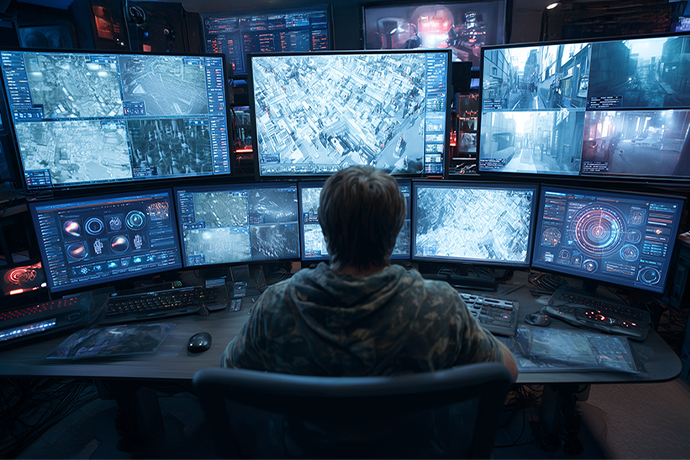AI-Powered Video Analytics
AI-Powered Video Analytics
AI-Driven ANPR: The Smart Solution for Traffic Challenges

India’s cities are growing at an unprecedented rate, and so are the challenges that come with managing urban infrastructure, especially traffic. With more vehicles on the road, traffic congestion, security threats, and road safety concerns are on the rise.
AI-driven ANPR technology like Drishticam can be a game-changer for urban infrastructure problem. By enabling real-time vehicle tracking, automating traffic rule enforcement, and enhancing security, this technology can help cities tackle congestion, reduce crime, and improve overall road safety.
Drishticam’s AI-powered ANPR is a system that uses machine learning and computer vision techniques to automatically read and recognise vehicle license plates from video footage. By integrating smart video management systems with AI-based video analytics, this technology can capture real-time data from traffic cameras and analyse vehicle number plates without human intervention. Drishticam ANPR systems work by analysing vehicle images, detecting the number plate, and converting the characters into digital data. This process occurs rapidly, enabling real-time traffic monitoring and enforcement.
The AI-driven approach allows the system to continuously learn and adapt to various environments, improving its accuracy and speed over time. Unlike traditional methods that rely on manual monitoring, AI-powered ANPR automates much of the process, enhancing efficiency and reducing human error.
How AI-powered ANPR Works
The backbone of an Drishticam AI-powered ANPR system is its video management system (VMS), which helps manage, store, and process large volumes of video data collected from various traffic monitoring cameras. These systems work together with AI algorithms to extract useful insights from the video footage.
The process begins with high-resolution cameras that capture continuous video streams of vehicles as they pass through the camera’s field of view. The video analytics software within the smart VMS identifies moving vehicles and applies image recognition techniques to locate the license plate. Once the license plate is identified, the AI model extracts the alphanumeric characters, even if the plate is partially obscured, dirty, or in poor lighting conditions.
AI algorithms are trained on vast datasets of license plates from diverse locations, ensuring they can recognise plates from different countries, fonts, and styles. This flexibility is a crucial feature, particularly for regions with high volumes of traffic, or where vehicles from different regions may be present.
Benefits of Drishticam AI-powered ANPR for Traffic Management
Automatic Number Plate Recognition (ANPR) using Drishticam offers a robust solution for vehicle identification through intelligent video surveillance.
1. Accurate License Plate Detection in Varying Lighting Conditions: Drishticam’s ANPR system is equipped with an advanced adaptive algorithm that ensures high accuracy in detecting and recognising license plates, regardless of environmental factors like bright sunlight or low-light conditions. This makes it ideal for real-world applications, where lighting can vary drastically throughout the day.
2. Fast and Efficient Search Capabilities: One of the standout features of Drishticam’s ANPR is its ability to quickly search and browse through registered license plates. This allows security personnel or administrators to access vehicle information in real-time, enhancing the speed and effectiveness of surveillance operations.
3. Minimal Error Rate: With its intelligent AI-powered video analytics, Drishticam’s ANPR ensures minimal errors in recognition, achieving an accuracy rate of over 90%, even in complex scenarios like vehicles with partially obscured plates or fast-moving traffic. This reliability makes it a trusted tool for critical applications such as law enforcement, parking management, and tolling systems, where precision is essential.
Improved Traffic Flow
Drishticam AI-driven ANPR systems play a pivotal role in reducing traffic congestion. By automating the process of vehicle identification, the system can be used for intelligent traffic signal control, vehicle tracking, and route optimisation. This can help reduce bottlenecks, optimise traffic light timings, and streamline the flow of vehicles, making roads safer and more efficient.
Real-Time Data and Analytics
AI-based video analytics integrated into the video management system allows for real-time data processing. This means that authorities can monitor traffic in real-time and take immediate action if needed. Whether it’s rerouting traffic during peak hours or responding to an accident or roadblock, AI-powered ANPR systems provide a wealth of data that can be analysed and used to make informed decisions quickly.
Seamless Integration with Other Traffic Management Systems
Drishticam AI-powered ANPR doesn’t operate in isolation. It can be seamlessly integrated with other traffic management systems, such as intelligent traffic lights, parking management solutions, and public transportation tracking systems. This synergy allows for a more holistic approach to managing traffic, ensuring smoother operations across all aspects of transportation.
In conclusion, Drishticam’s Automatic Number Plate Recognition (ANPR) technology powered by Drishticam AI algorithm stands out as a powerful tool for enhancing video surveillance and vehicle identification. Its ability to accurately detect license plates in diverse lighting conditions, combined with fast and efficient search functionalities and minimal error rates, makes it a reliable and essential solution for a wide range of applications.
Drishticam AI-powered ANPR represents the future of intelligent traffic management. By combining AI-driven video analytics with robust video management systems, this technology offers unprecedented accuracy, efficiency, and safety. As cities continue to grow, embracing AI-powered solutions like ANPR will be critical to overcoming the challenges of modern traffic management and ensuring smoother, safer roads for all.



